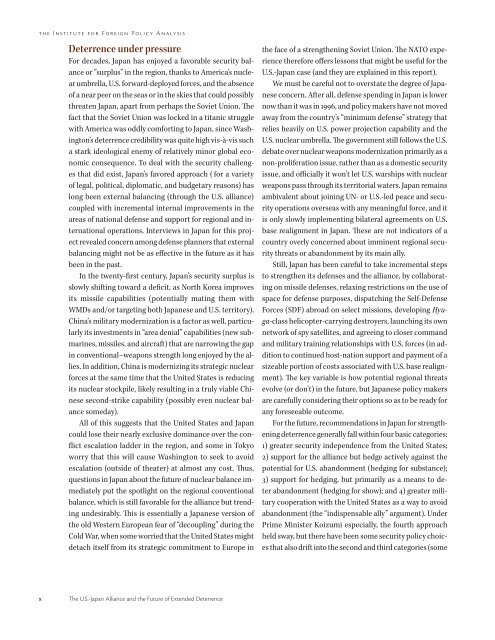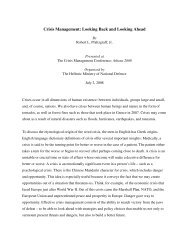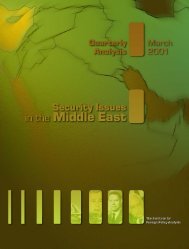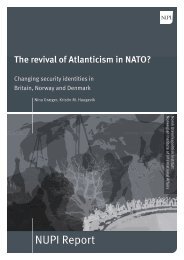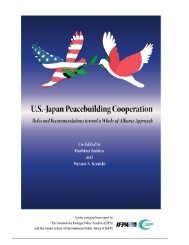Realigning Priorities: The U.S.-Japan Alliance and the Future of ...
Realigning Priorities: The U.S.-Japan Alliance and the Future of ...
Realigning Priorities: The U.S.-Japan Alliance and the Future of ...
You also want an ePaper? Increase the reach of your titles
YUMPU automatically turns print PDFs into web optimized ePapers that Google loves.
t h e I n s t i t u t e f o r F o r e i g n P o l i c y A n a ly s i s<br />
Deterrence under pressure<br />
For decades, <strong>Japan</strong> has enjoyed a favorable security balance<br />
or “surplus” in <strong>the</strong> region, thanks to America’s nuclear<br />
umbrella, U.S. forward-deployed forces, <strong>and</strong> <strong>the</strong> absence<br />
<strong>of</strong> a near peer on <strong>the</strong> seas or in <strong>the</strong> skies that could possibly<br />
threaten <strong>Japan</strong>, apart from perhaps <strong>the</strong> Soviet Union. <strong>The</strong><br />
fact that <strong>the</strong> Soviet Union was locked in a titanic struggle<br />
with America was oddly comforting to <strong>Japan</strong>, since Washington’s<br />
deterrence credibility was quite high vis-à-vis such<br />
a stark ideological enemy <strong>of</strong> relatively minor global economic<br />
consequence. To deal with <strong>the</strong> security challenges<br />
that did exist, <strong>Japan</strong>’s favored approach ( for a variety<br />
<strong>of</strong> legal, political, diplomatic, <strong>and</strong> budgetary reasons) has<br />
long been external balancing (through <strong>the</strong> U.S. alliance)<br />
coupled with incremental internal improvements in <strong>the</strong><br />
areas <strong>of</strong> national defense <strong>and</strong> support for regional <strong>and</strong> international<br />
operations. Interviews in <strong>Japan</strong> for this project<br />
revealed concern among defense planners that external<br />
balancing might not be as effective in <strong>the</strong> future as it has<br />
been in <strong>the</strong> past.<br />
In <strong>the</strong> twenty-first century, <strong>Japan</strong>’s security surplus is<br />
slowly shifting toward a deficit, as North Korea improves<br />
its missile capabilities (potentially mating <strong>the</strong>m with<br />
WMDs <strong>and</strong>/or targeting both <strong>Japan</strong>ese <strong>and</strong> U.S. territory).<br />
China’s military modernization is a factor as well, particularly<br />
its investments in “area denial” capabilities (new submarines,<br />
missiles, <strong>and</strong> aircraft) that are narrowing <strong>the</strong> gap<br />
in conventional–weapons strength long enjoyed by <strong>the</strong> allies.<br />
In addition, China is modernizing its strategic nuclear<br />
forces at <strong>the</strong> same time that <strong>the</strong> United States is reducing<br />
its nuclear stockpile, likely resulting in a truly viable Chinese<br />
second-strike capability (possibly even nuclear balance<br />
someday).<br />
All <strong>of</strong> this suggests that <strong>the</strong> United States <strong>and</strong> <strong>Japan</strong><br />
could lose <strong>the</strong>ir nearly exclusive dominance over <strong>the</strong> conflict<br />
escalation ladder in <strong>the</strong> region, <strong>and</strong> some in Tokyo<br />
worry that this will cause Washington to seek to avoid<br />
escalation (outside <strong>of</strong> <strong>the</strong>ater) at almost any cost. Thus,<br />
questions in <strong>Japan</strong> about <strong>the</strong> future <strong>of</strong> nuclear balance immediately<br />
put <strong>the</strong> spotlight on <strong>the</strong> regional conventional<br />
balance, which is still favorable for <strong>the</strong> alliance but trending<br />
undesirably. This is essentially a <strong>Japan</strong>ese version <strong>of</strong><br />
<strong>the</strong> old Western European fear <strong>of</strong> “decoupling” during <strong>the</strong><br />
Cold War, when some worried that <strong>the</strong> United States might<br />
detach itself from its strategic commitment to Europe in<br />
<strong>the</strong> face <strong>of</strong> a streng<strong>the</strong>ning Soviet Union. <strong>The</strong> NATO experience<br />
<strong>the</strong>refore <strong>of</strong>fers lessons that might be useful for <strong>the</strong><br />
U.S.-<strong>Japan</strong> case (<strong>and</strong> <strong>the</strong>y are explained in this report).<br />
We must be careful not to overstate <strong>the</strong> degree <strong>of</strong> <strong>Japan</strong>ese<br />
concern. After all, defense spending in <strong>Japan</strong> is lower<br />
now than it was in 1996, <strong>and</strong> policy makers have not moved<br />
away from <strong>the</strong> country’s “minimum defense” strategy that<br />
relies heavily on U.S. power projection capability <strong>and</strong> <strong>the</strong><br />
U.S. nuclear umbrella. <strong>The</strong> government still follows <strong>the</strong> U.S.<br />
debate over nuclear weapons modernization primarily as a<br />
non-proliferation issue, ra<strong>the</strong>r than as a domestic security<br />
issue, <strong>and</strong> <strong>of</strong>ficially it won’t let U.S. warships with nuclear<br />
weapons pass through its territorial waters. <strong>Japan</strong> remains<br />
ambivalent about joining UN- or U.S.-led peace <strong>and</strong> security<br />
operations overseas with any meaningful force, <strong>and</strong> it<br />
is only slowly implementing bilateral agreements on U.S.<br />
base realignment in <strong>Japan</strong>. <strong>The</strong>se are not indicators <strong>of</strong> a<br />
country overly concerned about imminent regional security<br />
threats or ab<strong>and</strong>onment by its main ally.<br />
Still, <strong>Japan</strong> has been careful to take incremental steps<br />
to streng<strong>the</strong>n its defenses <strong>and</strong> <strong>the</strong> alliance, by collaborating<br />
on missile defenses, relaxing restrictions on <strong>the</strong> use <strong>of</strong><br />
space for defense purposes, dispatching <strong>the</strong> Self-Defense<br />
Forces (SDF) abroad on select missions, developing Hyuga-class<br />
helicopter-carrying destroyers, launching its own<br />
network <strong>of</strong> spy satellites, <strong>and</strong> agreeing to closer comm<strong>and</strong><br />
<strong>and</strong> military training relationships with U.S. forces (in addition<br />
to continued host-nation support <strong>and</strong> payment <strong>of</strong> a<br />
sizeable portion <strong>of</strong> costs associated with U.S. base realignment).<br />
<strong>The</strong> key variable is how potential regional threats<br />
evolve (or don’t) in <strong>the</strong> future, but <strong>Japan</strong>ese policy makers<br />
are carefully considering <strong>the</strong>ir options so as to be ready for<br />
any foreseeable outcome.<br />
For <strong>the</strong> future, recommendations in <strong>Japan</strong> for streng<strong>the</strong>ning<br />
deterrence generally fall within four basic categories:<br />
1) greater security independence from <strong>the</strong> United States;<br />
2) support for <strong>the</strong> alliance but hedge actively against <strong>the</strong><br />
potential for U.S. ab<strong>and</strong>onment (hedging for substance);<br />
3) support for hedging, but primarily as a means to deter<br />
ab<strong>and</strong>onment (hedging for show); <strong>and</strong> 4) greater military<br />
cooperation with <strong>the</strong> United States as a way to avoid<br />
ab<strong>and</strong>onment (<strong>the</strong> “indispensable ally” argument). Under<br />
Prime Minister Koizumi especially, <strong>the</strong> fourth approach<br />
held sway, but <strong>the</strong>re have been some security policy choices<br />
that also drift into <strong>the</strong> second <strong>and</strong> third categories (some<br />
x<br />
<strong>The</strong> U.S.-<strong>Japan</strong> <strong>Alliance</strong> <strong>and</strong> <strong>the</strong> <strong>Future</strong> <strong>of</strong> Extended Deterrence


